Bone in ribeye is the ultimate steak for those who crave rich flavor and a perfect sear. With its rib bone adding depth and juiciness, this cut offers a robust flavor that’s hard to match. Our recipe is designed to highlight the steak’s rich marbling and buttery taste, bringing out its best with simple seasoning and a hot, cast-iron skillet.
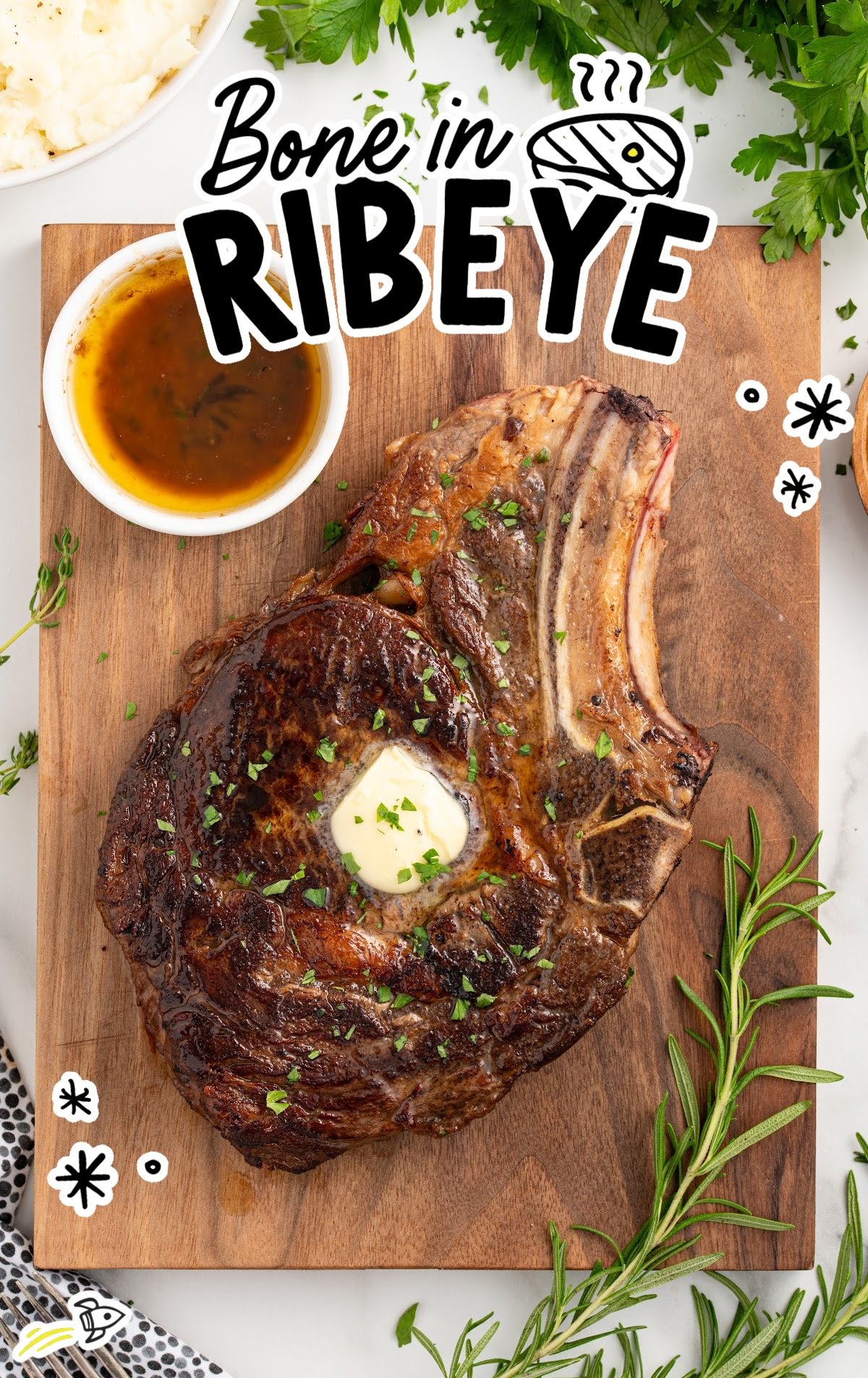
What You Need To Know
- MAIN INGREDIENTS: bone in ribeye steaks, kosher salt, black pepper, olive oil, garlic clove, fresh rosemary, fresh thyme, unsalted butter
- QUICK STEPS: season steaks, sear in hot skillet with olive oil, add garlic, herbs, and butter, baste steaks while cooking, rest steaks before serving
- TOTAL TIME AND YIELD: 15-20 minutes, 2 servings
Why This Recipe
- Our team of recipe developers fine-tuned every step, from the searing process to the resting time, ensuring you get a perfectly cooked bone in ribeye with a juicy, tender texture every single time.
- With just kosher salt, black pepper, and fresh herbs, this recipe brings out the rich, beefy flavor of the steak without overwhelming it. The combination of garlic, rosemary, and thyme enhances the natural taste without complicating the process.
- The recipe keeps things concise with a total cook time of just six to eight minutes for a medium rare steak, meaning you can enjoy a restaurant-quality bone in ribeye without spending hours in the kitchen.
Bone In Ribeye Ingredients
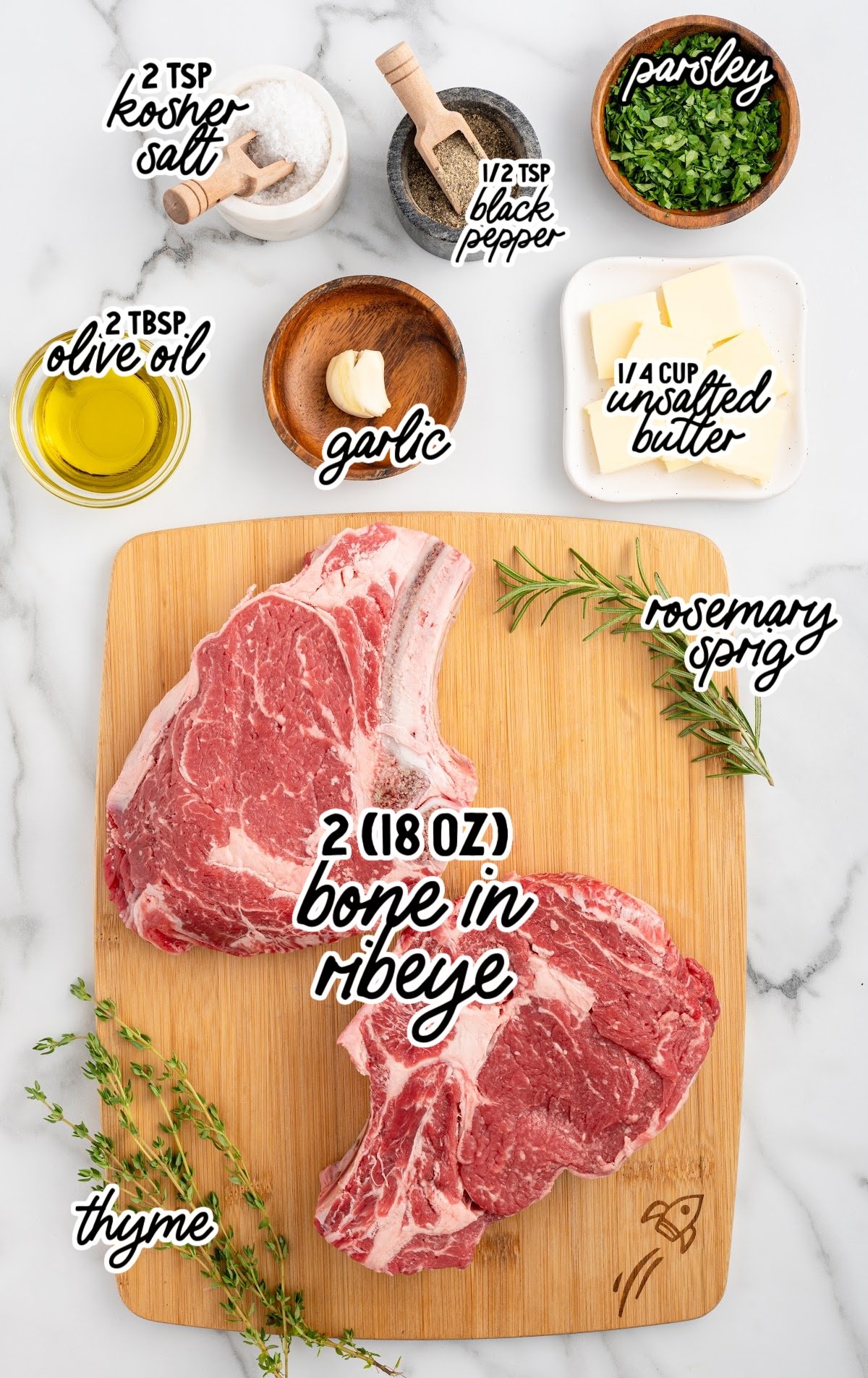
Cooking a bone in ribeye to perfection starts with the right ingredients. Each one plays a key role in bringing out the steak’s flavor and creating that ideal balance of rich marbling and juicy texture.
Here’s what you need:
- 2 (1 ¼ inch thick – approximately 18 ounces each) bone in ribeye steaks, room temperature
- 2 teaspoons kosher salt
- ½ teaspoon black pepper
- 2 tablespoons olive oil
- 1 large garlic clove (approximately 1 inch), slightly smashed
- 1 fresh rosemary sprig (approximately 4-5 inches long)
- 3 fresh thyme sprigs (approximately 6-7 inches long)
- ¼ cup unsalted butter
Optional Garnish:
- Pat of butter
- Fresh chopped parsley
Bone-In Ribeye Substitutions and Additions
Olive Oil: Swap with avocado oil or grapeseed oil. Both have a high smoke point, making them perfect for searing over high heat, just like olive oil.
Rosemary and Thyme: If you’re out of fresh herbs, you can use dried rosemary and thyme. Just be sure to use half the amount, as dried herbs are more concentrated. Sage or oregano could also be added for a different herbaceous note.
Unsalted Butter: Try using a compound butter made with herbs and garlic for a buttery taste with an extra layer of rich flavor. This can add depth to the steak without altering the cooking method.
How To Make Bone In Ribeye Steak
This easy and indulgent recipe is an excellent choice for a main course, that is packed with so much flavor. Follow our step-by-step instructions to create a delicious rib eye steak with a great sear every time.
STEP ONE: Allow the bone in ribeye steaks to sit at room temperature for 20-30 minutes before cooking. This helps them cook evenly and achieve that juicy texture. Pat the steaks dry with paper towels to remove any surface moisture, which will help create a good sear.
PRO TIP: Removing moisture is crucial. Moisture on the surface can lead to steaming rather than searing. Make sure the steaks are completely dry before you season them.
STEP TWO: Season both sides of the steaks generously with kosher salt and black pepper. Each side should get an even coating—about ½ teaspoon of salt and ⅛ teaspoon of pepper per side. Make sure to press the seasoning into the meat so it adheres well.
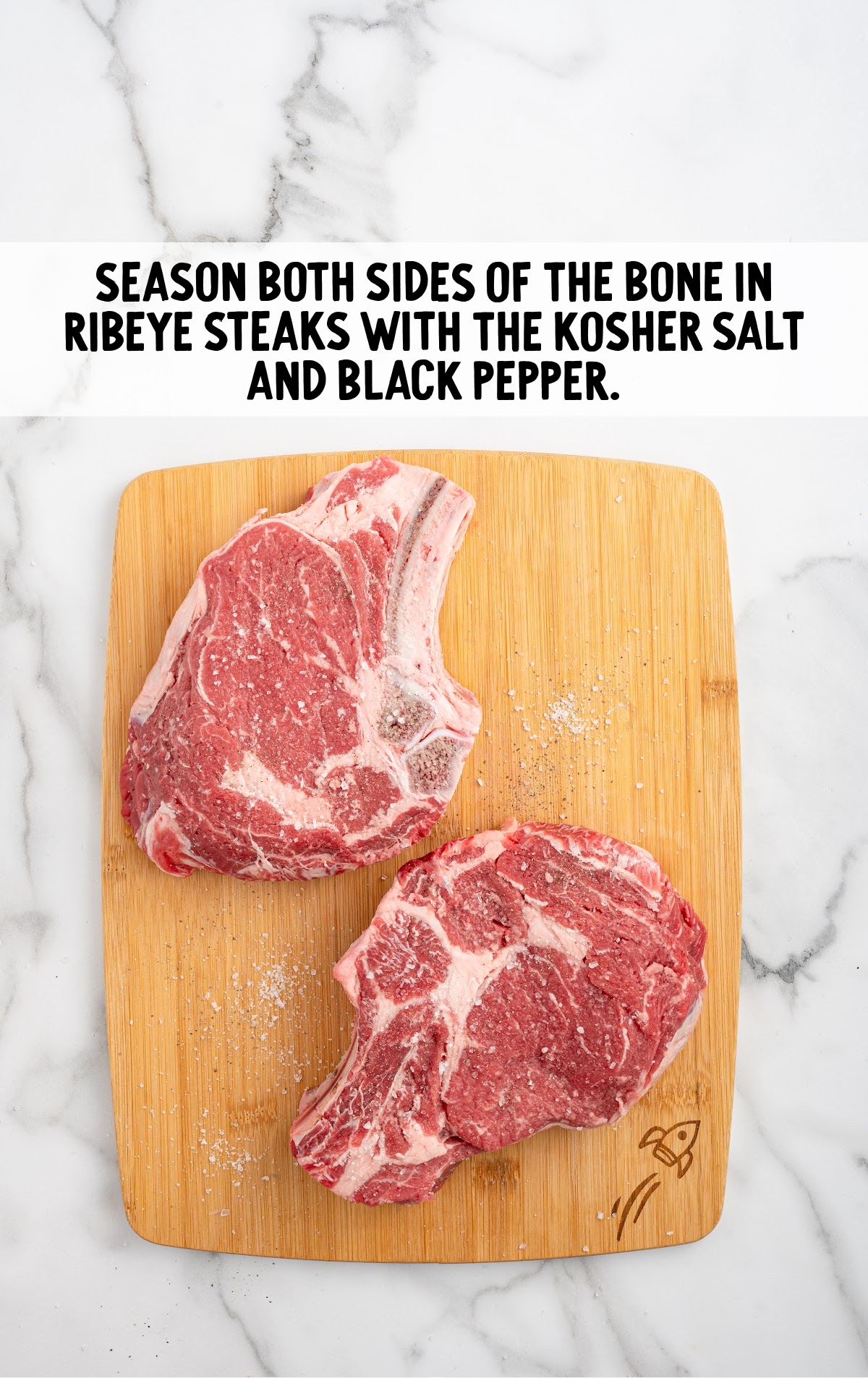
STEP THREE: Place a cast-iron skillet on medium-high heat. Let it get very hot before adding any oil—this is key to creating a perfect steak with a good sear.
STEP FOUR: Add the olive oil to the hot skillet, ensuring it coats the bottom evenly. Carefully place the seasoned bone in ribeye steaks into the skillet. Do not move them for three to four minutes, allowing the steaks to develop a golden-brown crust.
PRO TIP: Press the steaks down slightly when you first place them in the skillet to maximize surface contact. This will help achieve a better sear and enhance the rich flavor.
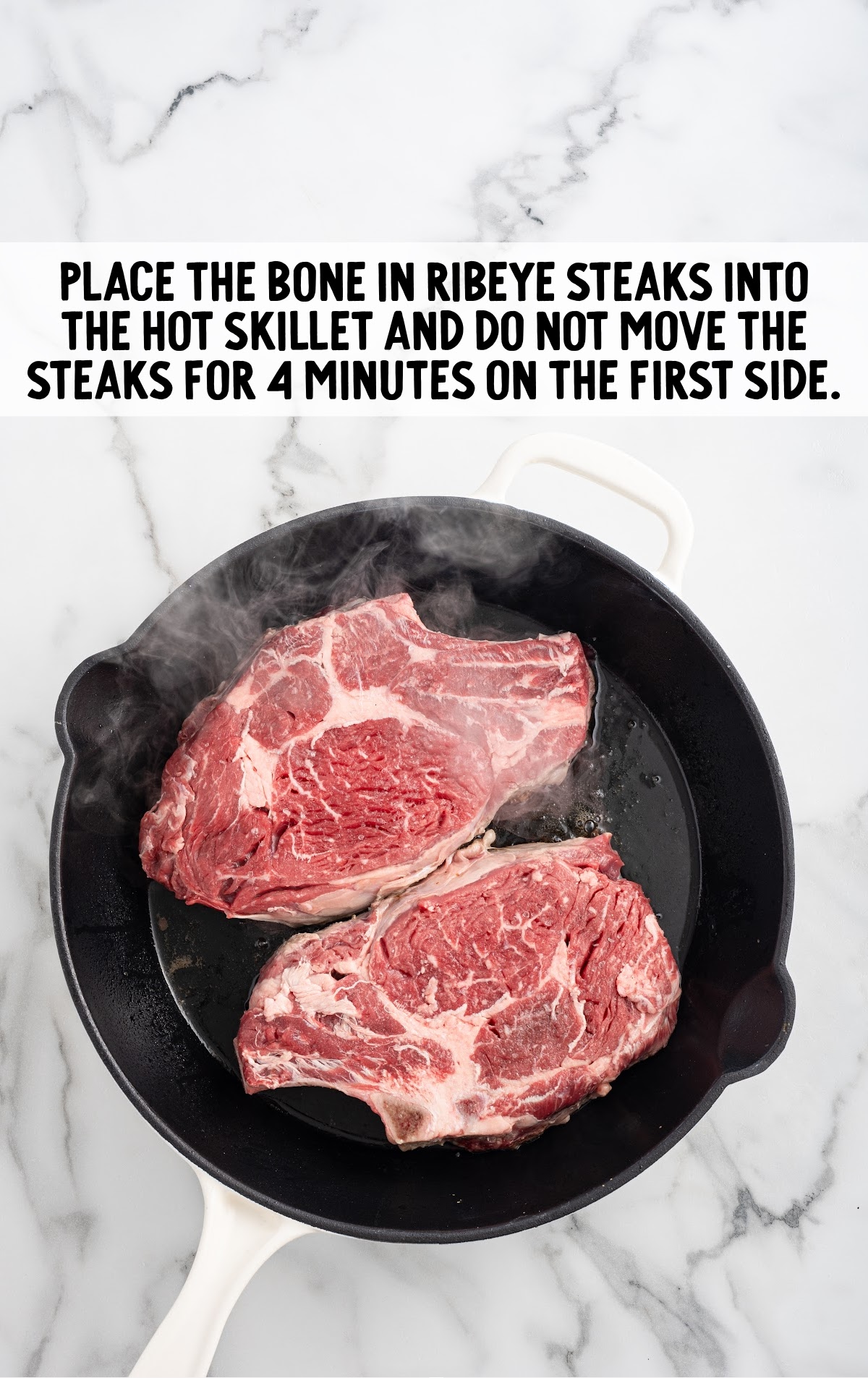
STEP FIVE: After three to four minutes, flip the steaks to the second side. Add the smashed garlic clove, fresh rosemary sprig, thyme sprigs, and unsalted butter to the skillet.
PRO TIP: Let the garlic cloves and herbs sit directly in the melted butter as it cooks. This will infuse the buttery taste into the steak while it finishes cooking.
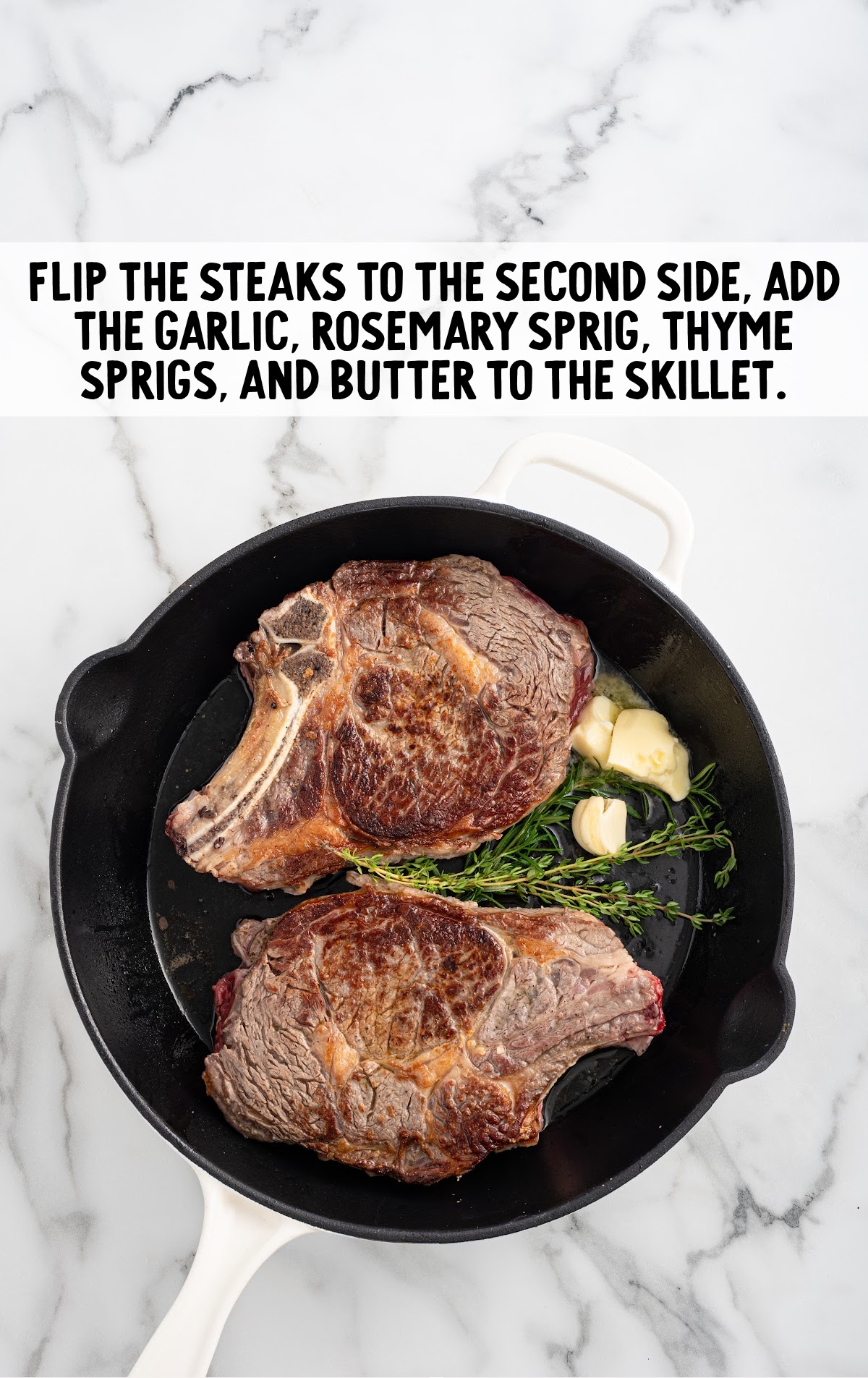
STEP SIX: While the steaks cook on the second side, use a spoon to continuously baste them with the melted butter and herbs. This process will enhance the robust flavor and keep the steaks moist. Cook for an additional three to four minutes, or until the internal temperature reaches 130°-133°F for medium rare steaks.
PRO TIP: If you prefer your steak cooked to a different doneness, adjust the cooking time and use a meat thermometer to check the internal temperature. For a juicy steak, it’s best to avoid cooking beyond medium.

STEP SEVEN: Take the steaks out of the skillet, leaving the herbs and garlic behind, and place them on a plate. Allow the steaks to rest for five to eight minutes.
PRO TIP: Resting the steak is essential because it allows the internal juices to redistribute, leading to a more tender and flavorful bite. During this resting time, the temperature of the meat will continue to rise by about three to five degrees.
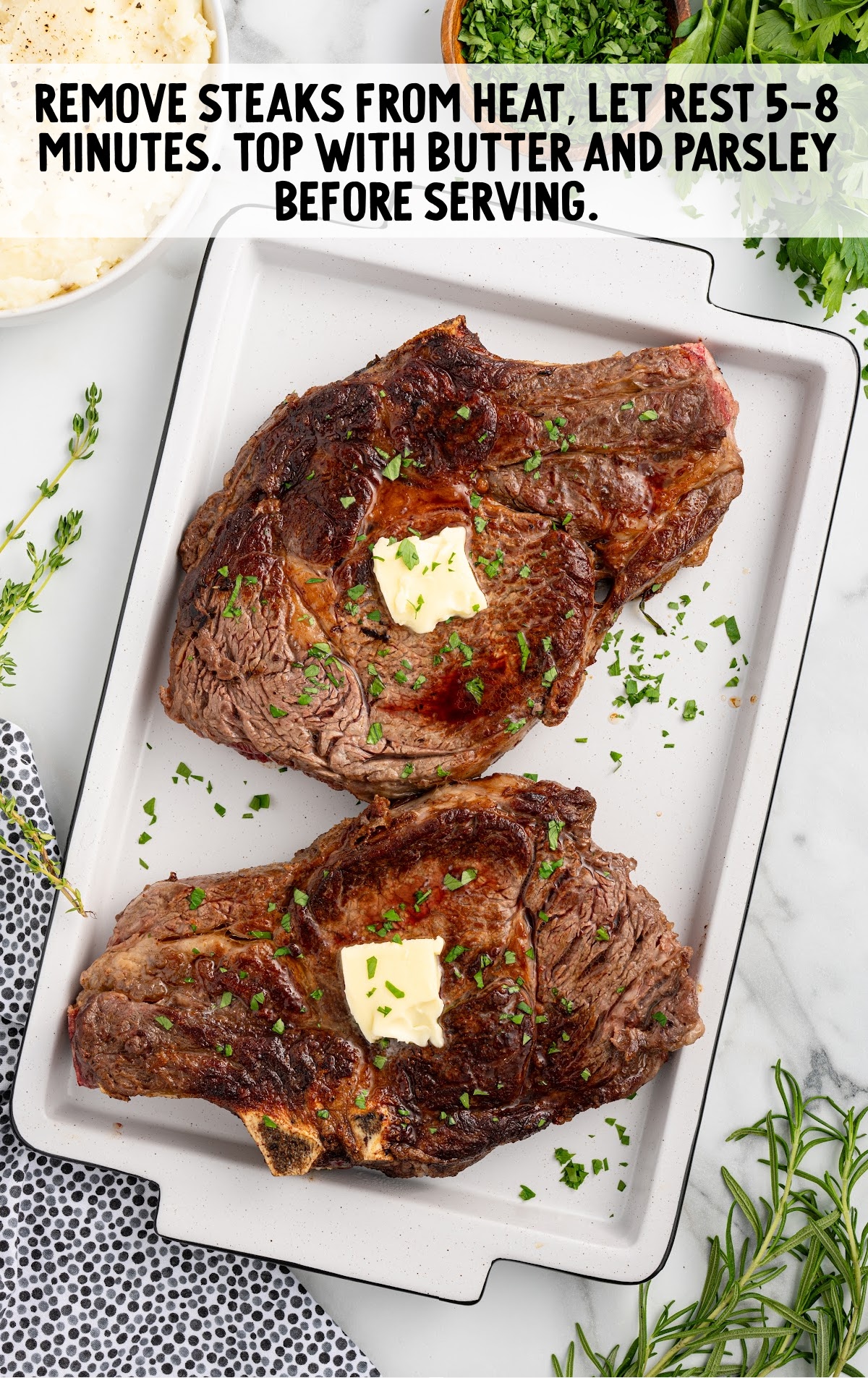
STEP EIGHT: Just before serving, add an optional pat of unsalted butter on top of each steak and sprinkle with fresh chopped parsley.
Troubleshooting This Bone In Ribeye Recipe
The steak is overcooked and not as tender as desired.
Use a meat thermometer to check the internal temperature. For medium rare, aim for 130°-133°F and remove from the heat promptly.
The butter and herbs burn while cooking.
If the skillet is too hot, reduce the heat slightly when you add the unsalted butter and herbs. This will prevent scorching and keep the rich flavor intact.
The steak is dry and lacks moisture.
Allow the steak to rest for five to eight minutes after cooking. This resting time lets the juices redistribute throughout the rib steak, making it more tender and flavorful.
The steak sticks to the pan, tearing the crust when flipped.
Let the steak sear undisturbed for the full three to four minutes before trying to flip. A hot skillet and a thin layer of olive oil help prevent sticking.
Uneven cooking with parts of the steak more done than others.
Make sure the bone in ribeye is at room temperature before cooking. If the steak is cold, it won’t cook evenly, leading to undercooked and overcooked spots.
The garlic burns, leaving a bitter taste.
Slightly crush the garlic and add it to the skillet with the butter, not before. This will let the garlic infuse flavor without burning.
How To Serve Bone In Ribeye
A bone in ribeye is a versatile and impressive dish, perfect for various occasions and dining experiences. Whether served as a classic steak dinner or repurposed for different meals, this juicy steak shines when paired thoughtfully or presented creatively.
Classic Steak Dinner: Pair the bone in ribeye with traditional sides like mashed potatoes, glazed carrots, and a buttery dinner roll.
Surf and Turf: Add sauteed shrimp or lobster tail to create an elevated meal. The steak’s rich marbling complements the seafood, and a drizzle of garlic butter ties the flavors together, making it ideal for date nights or celebrations.
Steak Salad or Tacos: Use leftover bone-in ribeye for easy, flavorful dishes. Thinly sliced steak on a bed of mixed greens with cherry tomatoes, blue cheese crumbles, and balsamic vinaigrette makes a fresh, light lunch. Alternatively, serve diced steak in tacos with fresh cilantro, lime wedges, and pickled onions for a tasty variation.
Steak and Eggs Brunch: Bring the steak into your brunch menu by serving it alongside scrambled eggs, hash browns, and sautéed mushrooms. It’s a hearty way to start the day and a great use of any leftovers.
Recommended Pairings:
- Bold Red Wine: A Cabernet Sauvignon or Malbec brings out the steak’s robust flavor.
- Creamy Sides: Zucchini gratin or roasted Brussels sprouts add richness and complement the buttery taste of the steak.
The bone in ribeye fits a range of occasions, from a cozy date night to a lively family gathering or weekend brunch. Its beefy flavor and versatile serving options make it a reliable choice for serving something special yet adaptable.
How To Store Bone In Ribeye
Properly storing your bone in ribeye will help maintain its rich flavor and juicy texture even after it’s cooked. Whether you’re planning to make it ahead, save leftovers, or freeze for later, here’s how to keep your steak at its best and how to reheat it when you’re ready to enjoy.
MAKE AHEAD: While this bone in ribeye is best cooked fresh, you can prepare it ahead by seasoning the steaks and letting them sit, covered, in the refrigerator for up to 24 hours. This allows the seasoning to penetrate, enhancing the flavor. When ready to cook, take the steaks out and let them reach room temperature before searing.
IN THE FRIDGE: Store leftover bone in ribeye in an airtight container or tightly wrapped in foil. It will keep well in the refrigerator for up to three to four days. Make sure to let the steak cool completely before storing to prevent condensation, which can affect texture.
IN THE FREEZER: To freeze, wrap the bone in ribeye tightly in plastic wrap and then in aluminum foil, or place it in a freezer-safe bag, removing as much air as possible. The steak can be stored in the freezer for up to two months. For the best texture when reheating, thaw it overnight in the refrigerator before warming up.
REHEATING: For reheating, use a low-temperature method to maintain the juicy texture of the steak. You can reheat in the oven at 275°F, placing the steak on a wire rack over a baking sheet for about 15-20 minutes, or until warmed through.
If using a skillet, sear the steak on medium-low heat, flipping occasionally to avoid overcooking.
Why We Love This Bone In Ribeye Recipe
There’s a lot to love about this bone-in rib eye recipe. It’s not just a steak; it’s a complete experience that brings together flavor, simplicity, and versatility. Whether you’re making it for a special occasion or just treating yourself, this recipe delivers in all the right ways.
Easy to Prepare: Straightforward steps and simple ingredients mean you can enjoy a restaurant-quality steak at home without stress.
Versatile Serving Options: Whether paired with classic sides or used in salads and tacos, this flavorful steak works well in different meal options.
Impressive Presentation: The bone-in cut not only adds flavor but also makes for an impressive presentation for special occasions.
Bone In Ribeye Frequently Asked Questions
Use a meat thermometer to check the internal temperature. For medium rare, the steak should reach 130°-133°F.
The rib bone in a bone in ribeye helps add robust flavor and enhances the overall juiciness of the steak while cooking.
Ideally, a bone in ribeye should be about 1 ¼ inch thick. This thickness allows the steak to develop a good crust without overcooking the center.
Use oils with a high smoke point, like olive oil, avocado oil, or grapeseed oil, to cook the bone in ribeye. These oils can handle the high temperature without burning.
This bone in ribeye recipe brings out the steak’s natural rich flavor and juicy texture, making it a reliable choice for any occasion. Whether it’s a special dinner or a casual meal, you’ll enjoy a perfectly cooked, restaurant-quality steak at home.
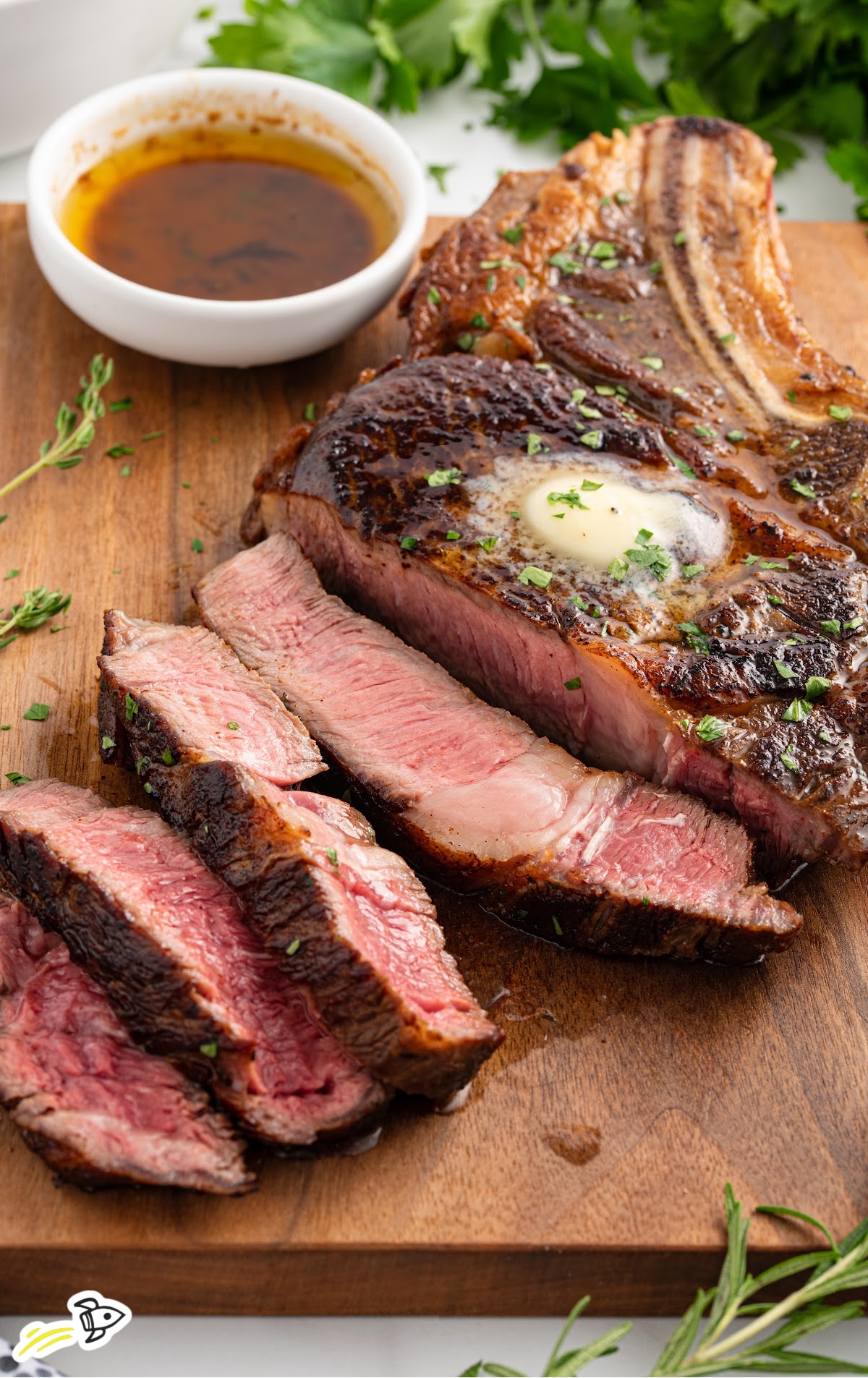
More Recipe’s You’ll Love
- Crock Pot Beef and Noodles
- Teriyaki Steak Bites
- Ground Beef Hash Brown Casserole
- Cheeseburger Burrito
- Sloppy Joe Pie
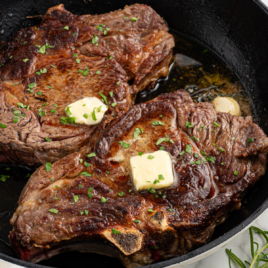
Bone In Ribeye
Ingredients
- 2 1 ¼ inch thick – approximately 18 ounces each bone in ribeye steaks, room temperature
- 2 teaspoons kosher salt
- ½ teaspoon black pepper
- 2 tablespoons olive oil
- 1 large garlic clove approximately 1 inch, slightly smashed
- 1 fresh rosemary sprig approximately 4-5 inches long
- 3 fresh thyme sprigs approximately 6-7 inches long
- ¼ cup unsalted butter
Optional Garnish
- Pat of butter
- Fresh chopped parsley
Instructions
- Allow the bone in ribeye steaks to sit, uncovered, at room temperature for 20 – 30 minutes to come to room temperature. This will help ensure even cooking for the steaks. Once the steaks reach room temperature, pat them dry really well with a paper towel to ensure they sear well in the skillet.
- Season both sides of the bone in ribeye steaks with the kosher salt and black pepper. Each side, of each steak, should get ½ teaspoon kosher salt and ⅛ teaspoon black pepper.
- Heat a large (12 inch) heavy duty skillet on medium-high heat. Once the skillet is very hot, add the olive oil to coat the bottom of the skillet. Place the seasoned bone in ribeye steaks into the hot skillet and do not move the steaks for 3-4 minutes on the first side. This will help give a beautiful golden sear to the steaks.
- Flip the steaks to the second side, add the smashed garlic clove, rosemary sprig, thyme sprigs and unsalted butter to the skillet. Be sure that the garlic and herbs are covered with the butter as it melts.
- Sear, and cook the bone in ribeye steaks on the second side for and additional 3-4 minutes, or until the internal temperature of each steak reaches 130°-133°F for medium-rare doneness. While the steaks are cooking on the second side, spoon the melted butter over the tops of each steak to flavor, and add moisture, the steaks.
- Remove the bone in ribeye steaks from the heat, leaving the sprigs of herbs and garlic clove in the skillet, and place them onto a plate to allow them to rest for 5-8 minutes to allow the internal juices of the steaks to redistribute before slicing and serving. During this rest time, the internal temperature will continue to rise another 3-5 degrees for a perfect medium-rare doneness.
- Before serving, you can add an additional pat of unsalted butter to the tops of each steak and a sprinkle of fresh chopped parsley for additional flavor and presentation of these bone in ribeye steaks.
Notes
- You will want to make sure the thickness of your bone in ribeye steaks are no more than 1 ½ inches thick. Any thicker and you will need to increase the cook time on each side to reach your preferred level of doneness.
- If you prefer your steaks cooked to a medium (135°-140°F), or medium-well (145°-150°F), then you will need to increase the cook time on each side until desired internal temperature is reached for each steak.
- In some areas, or grocery stores, bone in ribeye steaks are only sold during holiday seasons. You can certainly apply this cooking method to a boneless ribeye steak. You will want to be mindful that the total weight of each steak may vary, however, you are looking for a steak thickness of approximately 1 ¼ inch thick.
- Do not add too much black pepper to season the steaks before pan searing them as the black pepper can have a tendency to burn at that high of a cooking heat. You can always add more to the finished steaks if desired.
- A cast iron, or heavy duty aluminum, skillet works best for this recipe and method of cooking steaks.
- Remember that if you leave your seared, and cooked steaks, in the hot skillet to rest they will still continue to cook slightly from the residual heat from the heavy duty skillet. If you want the steaks to stay at a true medium-rare doneness, you will need to remove them completely from any heat source.
- The garlic, rosemary and thyme flavor the butter mildly, but just enough to impart a wonderful flavor to the steaks as they cook. You can certainly adjust the types of herbs used, or the amount used, according to your preferences.
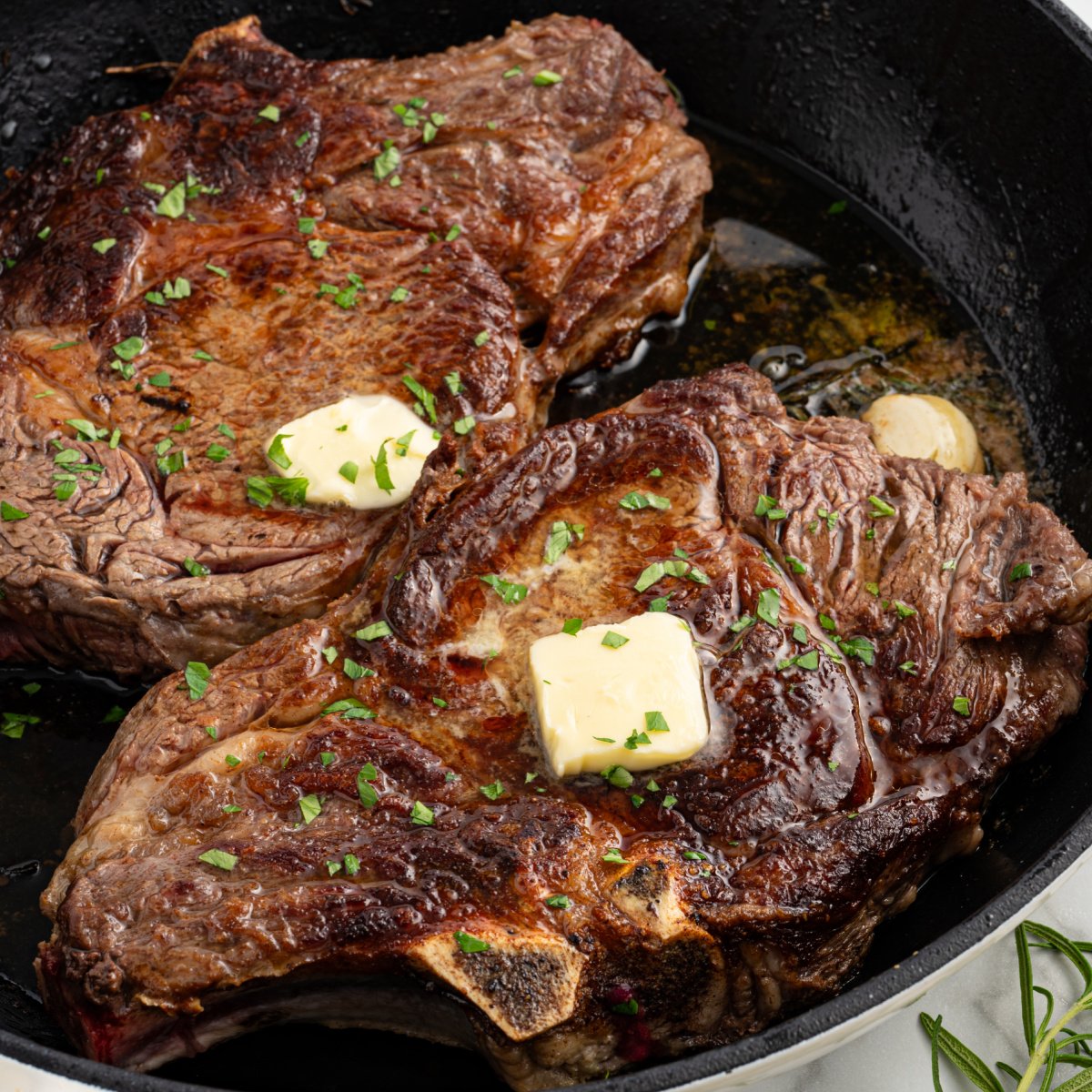
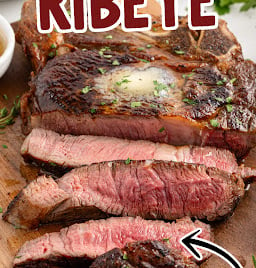
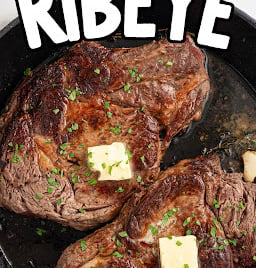



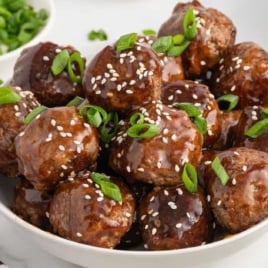



Leave a Comment